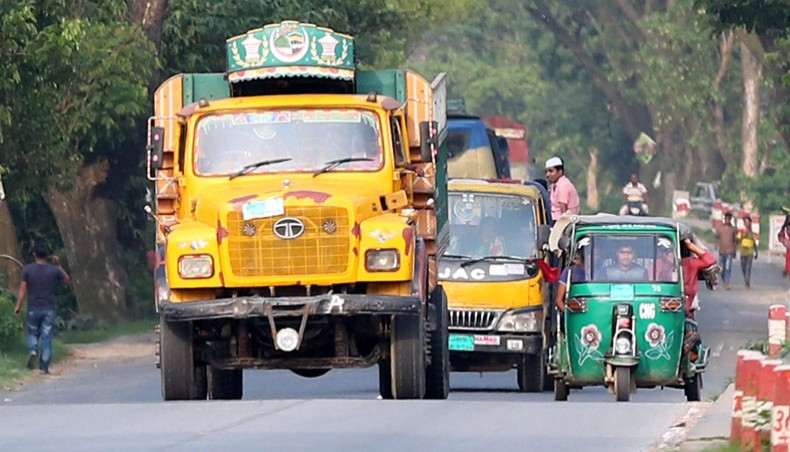Three-wheelers back on highways defying ban
Presence of three-wheeler auto-rickshaws, battery-run and non-motorised vehicles is once again noticeable on national highways across Bangladesh, leaving a government ban ineffective and causing fatal accidents almost every day.
Transport workers from different districts have alleged that these vehicles operate on national highways paying monthly ‘token’ money to political leaders, police and administration.
New Age correspondents in different districts report that CNG-run auto-rickshaws, battery-run easy bikes and rickshaws, shallow-engine-driven and locally-made Nasimon and Korimon, Bhatbhati and rickshaws are plying different highways even in broad daylight amid regular road mishaps.
Transport and bridges minister Obaidul Quader admitted recently that the number of deaths in road accidents was increasing due to three-wheelers on highways.
Road safety experts say that the situation would not improve without service roads by the highways and alternative public transports for common people, especially in suburbs and rural areas.
Road transport and bridges ministry imposed a ban on movement of three-wheeler and non-motorised vehicles on 22 national highways on August 1, 2015 in the wake of a spate in traffic accidents on the highways due to increasing presence of these vehicles.
On June 3, in a preparatory meeting over safe travel during the last Eid-ul-Fitr, Obaidul Quader had observed that the rate of accidents was currently low but the rate of deaths in road accidents was increasing due to presence of small vehicles like battery-run rickshaws and easy bikes on roads.
On June 9, he again directed the authorities concerned to stop movement of small and illegal vehicles.
Currently CNG or petrol-run auto-rickshaws have permission from Bangladesh Road Transport Authority to run on some city roads but not highways.
BRTA data, prepared based on police’s first information reports, shows that in 2017, a total of 2,513 people were killed and 1,898 in
jured in 2,562 accidents.
In 2016, the number of road accidents was 2,566, that of deaths 2,463 and that of injured people 2,234, the data shows.
Bangladesh University of Engineering and Technology’s Accident Research Institute assistant professor Kazi Md Shifun Newaz says these slow-moving vehicles increase the probability of road mishaps by encouraging over-taking by fast-moving vehicles on highway.
These vehicles are also of faulty design as they are locally-made and modified, he adds.
Passenger Welfare Association of Bangladesh secretary general Mozammel Haque Chowdhury alleges that these vehicles are operating under police and police patronisation.
Unless alternative transports are introduced, common people will continue to use these vehicles, he says.
Operation of three-wheelers, auto-rickshaws and other local human haulers on highways is rampant in Sylhet.
Takbir Ali, an auto-rickshaw driver of Munsirbazar at Bishwanath upazila, told New Age that he bought a monthly token from the police for Tk 600 for running his vehicle on Sylhet-Dhaka highway.
‘Several hundred drivers of our area are regularly buying these month tokens,’ Takbir said, adding that the token were sold by specific officials of the local police stations.
District Auto-rickshaw Driver Association leaders said more than 5,000 auto-rickshaws of Dakkhin Surama, Bishwanath, Osmani Nagar and Balaganj upazilas were operation on Sylhet-Dhaka highway while around 4,000 at Sadar, Goainghat, Jaintapur and Companiganj upalias plied Sylhet-Tamabil and Sylhet-Companiganj highways.
The drivers said what they would do as the ban was imposed without developing alternative ways for passengers.
Sherpur highway police officer-in-charge Bimal Chandra Bhowmik rejected the allegation of receiving money through token for allowing these vehicles on highways.
Sylhet district police superintendent Md Moniruzzaman said their efforts to stop movement of three-wheelers on highways were continuing.
New Age correspondent in Tangail reported that shallow-engine driven vehicles and battery-run easy bikes were running with passengers and goods on short distances in the district.
Transport workers claimed that they were giving police daily Tk 200 to Tk 300.
Despite mobile courts, CNG-run autos, easy bikes, tempo and Mahindra came back on Tangail-Aricha, Gazipur-Tangail and Tangail-Mymensingh-Jamalpur highways.
Autos are also running between Rabna bypass and Elenga, Elenga and Mymensingh and Modhupur and Sherpur.
New Age correspondent in Sirajganj reports that on Bogra-Nagarbari highway autos, non-motorised and other illegal vehicles are running.
These vehicles were running on 40 kilometre stretch between Baghabari under Shahjadpur upazila and Hatikumrul intersection under Ullapara upazila during day time.
There are 20 auto-rickshaw stands on the highway in Sirajganj road, Hatikumrul intersection, BSCIC bus stand, Dilruba bus stand, Talgachhi, Baghbari, Ullapara railway station bus stand and Shymoli Para bus stand areas.
Transport workers have alleged that they pay Tk 100 as monthly token money to police for running their vehicles.
New Age correspondent in Manikganj reports that three-wheeler and other illegal vehicles like ‘Hello Bike’ are running on Dhaka-Aricha national highway and regional highways in seven upazilas in the district.
The number of these vehicles in these areas increased in recent years to around 2,000, without registration from the authorities concerned.
New Age correspondent in Comilla reports that three-wheeler autos, locally known as Palli Bike, regularly run on different stretches on Dhaka-Chittagong highway all day long.
Transport workers have alleged that they cross Alekhar Char-Cantonment, Cantonment-Chandina, Chandina-Nimshar stretches on the highway by paying money to police.
A huge number of auto-rickshaws daily bring kitchen items to the two illegal highway-side kitchen markets at Chandina and Nimshar.
New Age correspondent in Cox’s Bazar reports that movement of three wheelers is rampant on busy Chittagong-Cox’s Bazar highway since the ban.
New Age correspondent in Chittagong reports that before the ban a huge number of autos were seen to run on Dhaka-Chittagong highway’s Mirer Sarai and Sitakunda areas.
After the ban, the movement has been limited.
News Courtesy: www.newagebd.net











